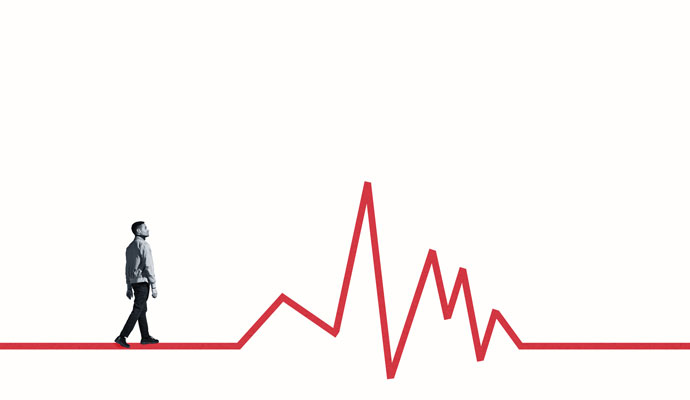Taking a Calmer View
The financial sector’s prospects in the wake of crisis may be better than you think.
(originally published by Booz & Company)As the current economic turmoil unfolds, it’s easy to lose sight of the long-term implications. The crisis mind-set in the financial-services sector, in particular, is understandable. Some of the world’s leading banking and insurance institutions are falling by the wayside. It is estimated that more than 100,000 professionals will have lost their jobs by the end of this year. Most ordinary savers around the world have lost significant portions of their pension and retirement savings. Governments are being tested, and leaders are under great pressure to intervene. The “bailouts” and other responses developed so far, however beneficial, will divert treasury and taxpayer money that might otherwise have been used to build infrastructure and support economic growth. Today’s level of market volatility has not been seen since the 1987 stock market crash. The size of the U.S. financial sector, the interconnected nature of financial markets, and the lightning-fast communication of news and rumor around the world have exacerbated the speed and scale of the crisis’s impact.
And yet, this is still a financial crisis, not a broad, fundamental economic meltdown. There is no sign of substantial risk of sovereign default in any of the major strong economies around the world. Moreover, the effects of this crisis will not be uniform. To be sure, many healthy banks and financial institutions are being punished by association; they are suffering from the shortage of credit and of investor confidence. But these effects will subside. As governments and central banks cordon off the problem institutions, a level of relative calm and confidence will return to the markets.
Even now, a number of financial-services organizations are surviving the crisis without major turmoil. They have a historic opportunity to capitalize on the events of the past six months and emerge better positioned than they have ever been before. Their next stage will be to develop new business models and revamp management practices for lasting success in the post-crisis world. The current uncertainty provides a base for their future advantage.
Thus, for those in the financial-services industry, now is not a time for knee-jerk responses. These times call for business and government leaders to take a calm look at the realities — to put in place measures that address economic fundamentals and establish a platform for success in the new era.
Remember, this crisis was not driven by economic or geopolitical fundamentals. It is rooted in the risk management of particular financial-services institutions. In the U.S. and western European banking systems in particular, a combination of incentives and market signals — the rise of asset values, the tax deductibility of mortgage interest, the nonrecourse rules (which prevent lenders from having access to borrowers after foreclosure), and the strong sales commission incentives in real estate — had led to easy consumer credit and inflated purchasing power. Financial institutions, chasing market share in a rising market, had used securitization in ever more complex varieties to fund their lending. Insurers, rating agencies, and regulators had all played an enabling role. Authorities reacted slowly and, on occasion, acted without the information needed to be effective (for example, the German government in its response to the near-collapse of the Hypo Real Estate holding company). In some cases, structural factors had delayed effective response: U.S. Federal Reserve measures, such as the lowering of fund rates, had been weakened by the amount of money tied up in longer-term instruments, such as fixed-rate mortgages.
As the denouement unfolds, three sets of opportunities are appearing: one for financial institutions in developed economies, one for the banks and financial-services industries in emerging economies (the so-called BRIC markets), and one for government regulators.
Developed Economies: A Smaller Winner’s Circle
Perhaps the most profound and enduring effect of the crisis will be the death of the business principles and models born 75 years ago with the Glass-Steagall Act in the United States. Markets will become significantly more concentrated in deposits and assets; investment and commercial banking institutions will continue to converge. This will lead to lower reliance on leverage in investment banking business models. And it is already setting the stage for the emergence of new boutique and niche models, operating independently of “large organization” cultures, and requiring limited capital.
The financial-services survivors in developed countries seem to be largely retail banks and wealth management companies. They are gaining significant market share — by attracting customers who seek security and quality and by taking advantage of opportunities for acquisition.
Three factors have helped them. First, they avoided the excesses of fast growth. Instead, they built strong franchises. The insurance companies among them relied not on investment returns but on innovative operating models. The retail and commercial banks maintained sound risk and capital management practices. The investment banks kept their exposure in check, close to their underlying assets.
Second, these surviving institutions have maintained strong capital positions and diversified funding sources. They have high levels of deposits and strong cash flows, plus a range of short- and long-term wholesale sources of funding in different markets. Additionally, they have maintained open communication channels to other potential sources of funding, such as sovereign wealth funds or institutions from less-affected markets such as Japan and the Middle East.
Third, they have communicated effectively with their boards and the market. Even the players with solid fundamentals can suffer if they are tainted with negative perceptions. The strongest players have avoided this.
These financial-services institutions are proactively restructuring their businesses to make the most of their new opportunities. They are divesting assets to raise capital, boosting their positions in emerging markets, raising capital through rights issues, simplifying their portfolios, increasing their productivity and performance, and looking closely at their risk management practices. We expect to see further consolidation.
Emerging Economies: Rapid Opportunity
In the faster-growing BRIC economies, challenges and opportunities vary by locality. Most large banks in these markets have escaped the worst effects of the crisis. In a few countries, like Russia, financial institutions face substantial challenges because of weaknesses in their home markets. But in most emerging nations, banks have very limited direct exposure to the asset classes in crisis, and they face limited risk of contamination from the U.S. and western Europe.
Moreover, most of these institutions have experienced rapid growth thanks to the real economic growth of their home countries and to the large numbers of new consumers using banking services for the first time. Of course, in the next year or two, this growth may slow down a bit. The weakened global economy could lead to lower export rates and reduced credit and liquidity. In China, a number of bank share offerings have already been postponed.
But for the first time, countries like China, India, and Brazil have strong internal markets and a robust institutional and regulatory apparatus. Financial institutions in these countries will be more resilient than in times past. Their greater economic diversification in recent years and structural competitive advantage in commodities will also help corporate risk profiles.
The strongest financial institutions in these markets will return, in the short term, to local financing, often with a focus on retail banking. As they manage their own fast credit growth environments, they will improve their risk controls and governance mechanisms. The wisest of them will partner with governments to develop new regulatory frameworks that are conducive to market growth and market security. Some of them, as they build scale and maintain market capitalization, will diversify and internationalize, taking advantage of their strong capital positions to merge with or acquire financial institutions in other parts of the world.
Governments: Rethinking Regulation
The capital markets have fundamentally changed. Globalization has not been halted; indeed, it is likely to accelerate after this crisis. New York and London will lose their preeminence to Shanghai, Dubai, and Singapore. Investors previously seen as relatively unimportant — particularly sovereign wealth funds and investors from oil-rich countries — are now critical enablers of the recapitalization of the world’s companies and economies. The major financial institutions of the new economies have grown in relative strength through this crisis, and they have clear ambitions to become leading global financial players.
The financial systems of the future are changing as well. The amount of trading will decrease as the markets de-leverage and the derivative-enabled speculation and hedging markets diminish. The market will be inherently less profitable; it will no longer contribute as much to overall employment and GDP in most markets. Employees will look to other industries for jobs; governments will look more to Main Street than to Wall Street for tax revenues.
The role of government will also change. Policymakers and governments will take as much interest in managing investment flows as they do in managing global trade. They will harmonize tax regimes, regulate foreign investment, and involve themselves more in foreign ownership and capital flow. Their goal: to prevent future crises and oversee the funding that they have injected into the markets. International agreements will be based more on pragmatic “rules of thumb” and less on complicated analytical models. Regulators will be open to well-formulated proposals on the design of measures that will support the building of institutions in this new world.
The crisis will ultimately create a healthy call for change and improvements in the financial world, particularly in risk control, governance, and regulation. Financial-services companies that focus on restructuring their businesses, partnering constructively with regulators, and tightening risk controls and capital strength can play an active role in the redesign of the global industry. For many of them, it will represent a natural evolution from the role they have played in this crisis. Now they must apply the same skills and capabilities as they move from short-term triage to build the next long-term platform of a sustainable global financial-services regime.![]()
Author profiles:
Klaus-Peter Gushurst is a Booz & Company senior partner based in Munich, and a member of the firm’s global board of directors. He specializes in strategy, turnaround and restructuring, and corporate management, primarily in the financial-services and automotive industries.
Ivan de Souza is a Booz & Company senior partner. A member of the firm’s global board of directors, he oversees the firm’s Latin America business. He specializes in strategy, marketing, and organization services for financial institutions and conglomerates.
Vanessa Wallace is a Booz & Company partner and leads the financial-services practice in Asia, Australia, and New Zealand. She specializes in strategy, post-merger integration and restructing in retail banking, wealth management, insurance and the public sector.
Also contributing to this article were Booz & Company Partners Andrew Cainey and Charles Teschner.




